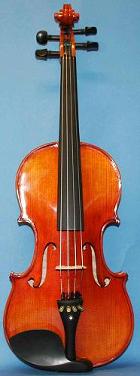
Is it Better to buy a New or a Used Violin ? - check out the facts
Thoughts about New Violins
There is nothing quite like getting a brand new violin, the shine and the smell of the new varnish every time you open the case and tuck it under your chin is a pleasure that lasts for quite a while. Hopefully it won't have any chips and cracks and it will be correctly made and set up. Even more importantly it will be nice to play and respond to your every change of bow stroke.
A good new violin should improve with age, the wood, even though well seasoned, will dry even more and subtle changes to the varnish as it ages will often improve the tone of a violin. There's also this mysterious fact that many violinists talk of, "A violin gets better the more you play it". For some reason Violins bed down over a period of time. It's especially noticeable when you change strings, a couple of weeks of playing can often transform a set of new strings.
A new violin should last a lifetime if is well looked after, you shouldn't have to worry about any repairs coming undone and old cracks re-appearing. it's a fantastic investment, no other purchase has the potential to give you so much enjoyment and fulfillment.


Thoughts about Old Violins
A well cared for second hand student violin could be as good if not better than the new equivalent. It's tone woods will have matured and often you'll find that the violin has been fitted with better strings than original.
Older used violins often produce a more mellow tone than the modern violin. Some of this is due to the aging of the tone woods and some is due to the modern trend of making louder instruments. Older violins are often made of better quality wood than modern violins. Wood like Ebony for example wasn't as scarce in the past as it is now.
Unfortunately not all violins are looked after as well as they should be and it is not unusual to find old violins with cracks on the top plate (table) and sometimes on the back too. These are usually caused by the violin being kept in too dry an environment. The Spruce top tends to shrink more than the Maple surround, Spruce is a softwood, so lots of strain is put on the plate as it dries, which either breaks the glue joint between the plate and the ribs or cracks the top plate.
Shrinkage cracks are usually fairly easy to repair. Violins are glued with a water based animal hide glue and it is possible to unglue and re-glue the seams. This means it is possible to remove the top plate. glue and reinforce the crack and then replace the top plate. You'll often find old violins with repaired cracks, if the repair has been well executed the violin should be fine.
Most violins get the odd dent or scratch, unless the damage is quite severe this will not affect the tone and for some people these signs of use attract them to the instrument.
Just because a violin is old it doesn't mean that it is set up correctly. In our workshops we carefully inspect all the second hand violins we acquire and adjust the pegs, bridge, soundpost, fingerboard and nut as required before fitting a good set of strings. It is very rare to find one that doesn't need any adjustment.
Old violins are getting more rare, there is a fixed stock of them so it would seem likely that the price will rise as the years pass by.
Well what do you choose, New or Used? the choice is yours. If you can't stand the look of a well used instrument then you should have a new violin. It will probably improve but might be a bit difficult to tame until it settles down whereas a used violin might have a more mellow sound but is unlikely to improve even though it is easier to play now.
Lastly be aware that just because a violin is old it doesn't mean it has got to be good. There have always been well made expensive violins and poorly made inexpensive violins. Even Stradivarius didn't always make top quality violins.